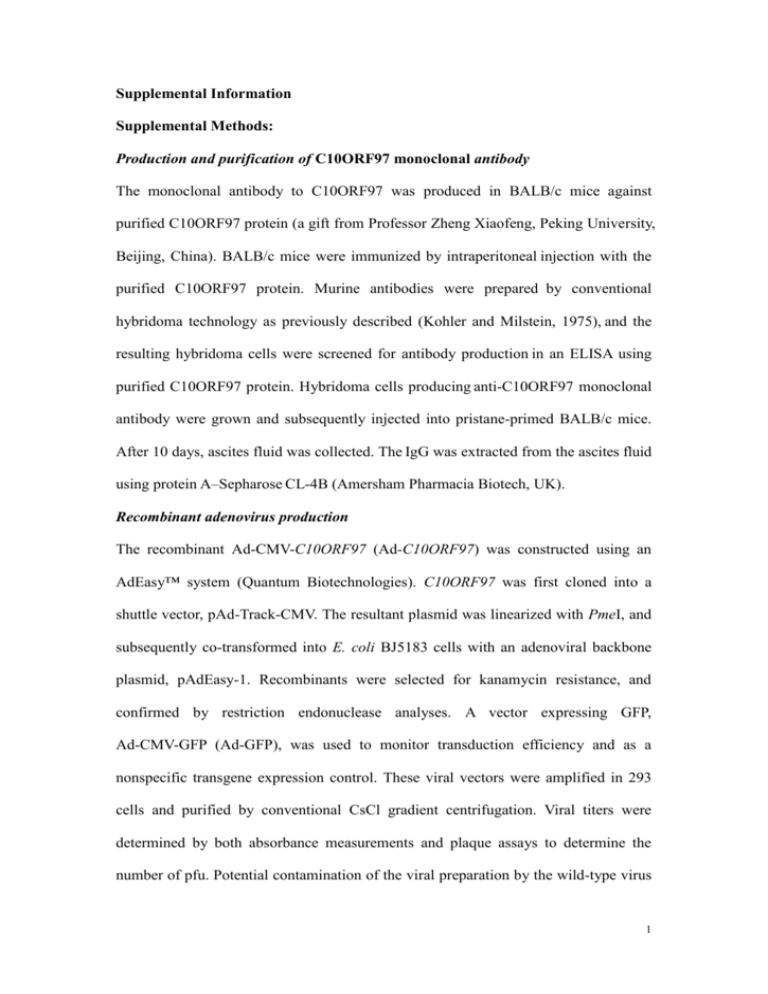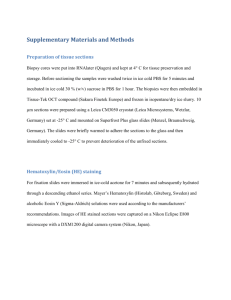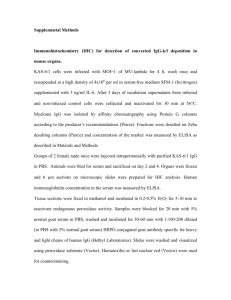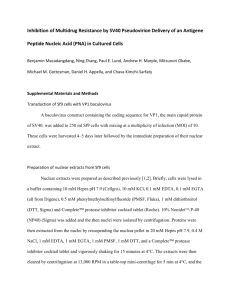Supplemental Information
advertisement

Supplemental Information Supplemental Methods: Production and purification of C10ORF97 monoclonal antibody The monoclonal antibody to C10ORF97 was produced in BALB/c mice against purified C10ORF97 protein (a gift from Professor Zheng Xiaofeng, Peking University, Beijing, China). BALB/c mice were immunized by intraperitoneal injection with the purified C10ORF97 protein. Murine antibodies were prepared by conventional hybridoma technology as previously described (Kohler and Milstein, 1975), and the resulting hybridoma cells were screened for antibody production in an ELISA using purified C10ORF97 protein. Hybridoma cells producing anti-C10ORF97 monoclonal antibody were grown and subsequently injected into pristane-primed BALB/c mice. After 10 days, ascites fluid was collected. The IgG was extracted from the ascites fluid using protein A–Sepharose CL-4B (Amersham Pharmacia Biotech, UK). Recombinant adenovirus production The recombinant Ad-CMV-C10ORF97 (Ad-C10ORF97) was constructed using an AdEasy™ system (Quantum Biotechnologies). C10ORF97 was first cloned into a shuttle vector, pAd-Track-CMV. The resultant plasmid was linearized with PmeI, and subsequently co-transformed into E. coli BJ5183 cells with an adenoviral backbone plasmid, pAdEasy-1. Recombinants were selected for kanamycin resistance, and confirmed by restriction endonuclease analyses. A vector expressing GFP, Ad-CMV-GFP (Ad-GFP), was used to monitor transduction efficiency and as a nonspecific transgene expression control. These viral vectors were amplified in 293 cells and purified by conventional CsCl gradient centrifugation. Viral titers were determined by both absorbance measurements and plaque assays to determine the number of pfu. Potential contamination of the viral preparation by the wild-type virus 1 was monitored by PCR analysis. Stealth siRNA treatment C10ORF97 stealth siRNA (No. HSS129272) and the negative control were purchased from Invitrogen. A549 cells were transfected with 20 pmol of C10ORF97 stealth siRNA or the negative control using the Lipofectamine 2000 transfection reagents (Invitrogen) in 1 ml of OptiMEM (Invitrogen) according to the manufacturer's instructions. The level of IC53 expression was determined by real-time RT-PCR. Real-time RT-PCR A549 cells were treated with Ad-C10ORF97, Ad-GFP, siRNA-C10ORF97, siRNA-control or PBS for 48 h. Then, total cellular RNA was isolated from the cells using Trizol reagent (Invitrogen). The C10ORF97 mRNA copies were quantified using a real-time RT-PCR kit (Takara, Japan) on a Bio-Rad iQ5 Sequence Detection System (Bio-Rad, Hercules, CA, USA). The primers used for C10ORF97 were: forward: 5'-GACGGGACATGCTGTTTCTA-3' and reverse: 5'-CAGGGGCAACTAAAGCCATA-3'. The primers used for GAPDH were: forward: 5'-AGAAGGCTGGGGCTCATTTG-3' and reverse: 5'-AGGGGCCATCCACAGTCTTC-3'. GAPDH was amplified to normalize the C10ORF97 mRNA expression. The copy numbers of GAPDH and C10ORF97 were determined according to each standard curve. Relative C10ORF97 mRNA levels (Supplemental Figure 1) were determined by comparing the PCR cycle thresholds between the cDNA of C10ORF97 and that of GAPDH. Cell proliferation assays Cell proliferation was determined by a 3-(4,5-dimethylthiazol-2-yl)-2,5-diphenyltetrazolium bromide (MTT) assay. A549 cells were seeded in 96-well plates (2×103 cells/well) for 24 h before serum 2 deprivation and treatment with Ad-C10ORF97, Ad-GFP, siRNA-C10ORF97, siRNA-control or PBS. At the indicated time, the media was carefully removed and 100 µl of MTT solution (1 mg MTT/ml medium) was added to each well, and plates were incubated for 4 h at 37°C until a purple precipitate was visible. The media was then replaced with 100 µl of DMSO, and the plates were shaken to dissolve the precipitate. The results were quantified by measuring the absorbance at 570 nm with a microplate reader (Bio-Rad). Cell migration assay The cell migration assay was performed using 24-well transwell units (Costar, Cambridge, MA, USA) with an 8-µm pore size polycarbonate filter. The transwells were coated with 20 µg/ml type I collagen (BD Biosciences) and incubated at 4°C overnight. They were then blocked with 0.1% BSA in PBS for 1 h at 37°C. After washing with PBS, the wells were seeded with cells at a concentration of 2×105 cells/ml in cell medium containing 0.1% BSA (Sigma Chemicals, St. Louis, MO, USA). The bottom chambers were filled with 600 µl of cell medium containing 0.5% FBS, and the top chambers were seeded with 100 µl of cell suspension (2×104 cells/well) which had been treated with Ad-C10ORF97, Ad-GFP, siRNA-C10ORF97, siRNA-control or PBS for 48 h. Cells were allowed to migrate for 4 h at 37°C. After incubation, cells on the top surface of the membrane (non-migrated cells) were scraped with a cotton swab. Whereas, cells on the bottom side of the membrane (migrated cells) were stained with 0.5% crystal violet dye (Fisher Scientific, Springfield, NJ, USA) in 70% ethanol for 30 min. The cells were then destained in PBS, and the membrane was left to air dry at room temperature. Migrated cells were counted using a Nikon inverted microscope (Nikon, Japan). Six independent areas per filter were counted, and the mean number of migrated cells was calculated. 3 Cell adhesion assay Untreated, 24-well, flat-bottomed tissue culture plates (Costar) were used in the cell adhesion assay. The plates were coated with 10 µg/ml Matrigel (BD Biosciences) and incubated at 4°C overnight, they were then blocked with 2% BSA for 30 min at 37°C. Cells were treated with Ad-C10ORF97, Ad-GFP, siRNA-C10ORF97, siRNA-control or PBS for 48 h. The cells were trypsinized, washed and resuspended at a concentration of 2×105 cells/ml in serum-free medium containing 0.1% BSA. The cell suspension (500 µl) was then added to each well, and the plates were incubated at 37°C for 45 min in 5% CO2. At the end of the incubation, the media containing unattached cells was removed, and 500 µl of MTT solution (1 mg MTT/ml medium) was added to each well. Each plate was then incubated for 4 h at 37°C until a purple precipitate was visible. The media was then replaced with 100 µl of DMSO, the plates were shaken to dissolve the precipitates, and the suspensions were added to the wells of a 96-well plate. The results were quantified by measuring the absorbance at 570 nm with a microplate reader (Bio-Rad). Soft agar colony-forming assay Soft agar colony-forming assays were performed at least in triplicate. Cells (1.5×103/ml), which had been treated with Ad-C10ORF97, Ad-GFP or PBS, were plated onto 60 mm culture dishes in medium containing 0.35% agar overlying a 0.7% agar layer. Three dishes were used per each group. Cells were cultured at 37°C for 15 days in a humidified CO2 incubator. Colonies were visualized by microscopy. Cell cycle analysis Cells were plated in six-well plates (5×105 cells/well) and infected with adenoviral vectors. PBS containing no viral constructs was used as a control. Cells (including floating cells in the medium) were harvested at the indicated times, washed twice with 4 PBS and fixed with pre-chilled 70% ethanol at 4°C for at least 24 h. The cells were then pelleted by centrifugation at 1000 rpm, washed twice with PBS. resuspended in 300 µl of PBS, digested with 200 µl of Rnase A (50 µg/ml) at 37°C for 30 min, placed on ice for 2 min, stained with 500 µl PI solution (PI 20 µg/ml, Triton X-100 1.0%, NaCl 0.9%) at 4°C in the dark for 40 min, and then analyzed in a FACSCAN flow cytometer equipped with a double discriminator using the LYSYS II and CELLFIT software (Becton-Dickinson & Co., San Jose, CA, USA). Microarray analysis RNA was isolated from A549 cells transfected with Ad-C10ORF97 or Ad-GFP. The mRNA isolated from 200 µg of total RNA was then processed for microarray analysis. Briefly, cDNA synthesis, in vitro transcription and labeling were performed as instructed by the manufacturer's user manual (Clontech). Probes were hybridized to the Atlas human cancer array (Clontech, Cat#7742-1) in a Hybridization Oven Robbin 1000 (Robbin). The results were visualized using a phosphoimager (BAS-MS 2340, Fujifilm) and data were analyzed using ArrayGauge version 1.0 software (Fuji). Western blot analysis Cells were harvested at 90% confluence. Whole cell extracts were prepared by detergent solubilization in lysis buffer (50 mM Tris-HCl, 150 mM NaCl, 0.1% SDS, 0.02% sodium azide, 1 mM EDTA, 1 mM EGTA, 1% NP-40, 10 µM leupeptin, 100 µg/ml phenylmethylsulfonyl fluoride, 1 µg/ml aprotinin) for 1 h at 4°C. The cell extracts were then subjected to western blotting, using antibodies purchased from Santa Cruz or Sigma, and visualized with the ECL detection system (Amersham Corp.). Plasmids for yeast two-hybrid screening We amplified the full-length C10ORF97 gene by PCR and inserted it into the 5 pGBKT7 vector. The full-length JAB1 coding sequence was amplified by PCR from the human heart cDNA library, and was then inserted into the pCDNA3.1A and pCMV-HA vectors. For coimmunoprecipitation, we amplified the full-length C10ORF97 gene and inserted it into the pCMV-Myc vector. All constructs were confirmed by DNA sequencing analysis. Yeast two-hybrid screen The Matchmaker 3 GAL-4-based yeast two-hybrid system (Clontech) was used. pGBKT7-C10ORF97 was constructed by fusing the full-length C10ORF97-coding sequence in-frame to the Gal4 DNA-binding domain in the pGBKT7 vector as described above. Saccharomyces cerevisiae strain AH109 (Clontech) was stably transformed with the bait vector pGBKT7-C10ORF97 under tryptophan-deficiency selection, and the full-length C10ORF97 gene was found to lack autonomous transactivation activity. S. cerevisiae strain AH109 yeast cells expressing bait plasmids were mated with a pre-transformed human heart MATCHMAKER cDNA library in Y187 cells (Clontech), and were then plated onto media supplemented with 5 mM 3-amino-1,2,4-triazole (Sigma) and lacking tryptophan, leucine, adenine and histidine. Approximately 3×107 colonies were screened. Positive colonies were re-streaked onto fresh media. Yeast plasmid DNA was isolated and used to transform competent Escherichia coli DH5α cells. Plasmids isolated from DH5α transformants were sequenced. Co-transfection of A549 cells A549 cells were maintained in F12 medium (Gibco BRL) supplemented with 10% FBS and antibiotics. Cells (at 70% confluence) were co-transfected with pCMV-Myc-C10ORF97 and pCMV-HA-JAB1, pCMV-Myc-C10ORF97 and pCMV-HA, pCMV-Myc and pCMV-HA-JAB1, pCDNA3.1-p27, pCDNA3.1-p27 6 and pCDNA3.1-JAB1, pCDNA3.1-p27 and pCDNA3.1-JAB1 and pCDNA3.1-C10ORF97 using the Lipofectamine 2000-mediated transfection method (Invitrogen). These experiments were carried out 48 h after transfection. Coimmunoprecipitation analysis Whole cell lysates were immunoprecipitated with 4 µg of anti-HA polyclonal antibodies (Clontech) for 2 h at 4°C. The primary polyclonal antibodies were incubated with protein A-agarose (Sigma) for 1 h at 4°C. The resulting immunoprecipitates were then subjected to SDS-polyacrylamide gel electrophoresis and western blotted as described above. Immunofluorescence microscopy Forty-eight hours after transfection, cells were detached from dishes and transferred onto sterile glass slides. Cells grown on glass slides were washed with PBS, dried and fixed for immunostaining by incubation with a freshly prepared solution of cold methanol/acetone (1:1) for 10 min. After fixation, cells were dried and incubated in blocking buffer (1% BSA in PBS) for 30 min. Cells were incubated with either anti-Flag monoclonal antibody (Sigma) or anti-p27 monoclonal antibody (Sigma) at a 1/100 dilution in blocking buffer for 1 h and were then washed three times with PBS. Cells were incubated with goat Texas red-conjugated anti-mouse IgG (Becton Dickinson-PharMingen) at a 1/200 dilution in blocking buffer for 60 min and were then extensively washed again with PBS. For all types of staining, cells were incubated with 0.1 Ag/mL of 4,6-diamidino-2-phenylindole (DAPI; Sigma) to stain the nuclei. Samples were examined on a LSM510 confocal microscope (Carl Zeiss, Göttingen, Germany). Immunofluorescence co-location assays Cells were plated on glass coverslips 16 h after transfection with the 7 pCMV-HA-JAB1 and pCMV-Myc-C10ORF97 vectors, and were then grown for 1–2 days prior to staining. Cells were fixed in a freshly prepared solution of cold methanol/acetone (1:1) for 10 min. After fixation, cells were dried and incubated in blocking buffer (1% BSA in PBS) for 30 min. Cells were incubated with mouse anti-HA (Sigma) and goat anti-Myc (Sigma) monoclonal antibodies at a 1/100 dilution in blocking buffer for 1 h, and were then washed three times with PBS. Cells were incubated with FITC-labeled anti-mouse IgG (Santa Cruz, CA, USA; dilution 1:100) and TRITC-labeled anti-goat IgG (Santa Cruz; dilution 1:100) in blocking buffer for 60 min. Following incubation with the secondary antibodies, slides were washed with PBS, then mounted on glass slides and analyzed on the confocal microscope for the detection of C10ORF97 and JAB1. Transient transfection of the reporter gene A549 cells (1.5106 cells/plate) were seeded into 60-mm cell culture plates and then incubated for 48 h to ~80% confluence. Cells were then cotransfected with pRL3-luciferase (0.02 μg), AP-1-driven luciferase reporter constructs (0.5 μg), pCDNA3.1-JAB1 (1 μg) or different amounts of pCDNA3.1-C10ORF97 (1, 2 or 3 µg). Plasmid pRL-SV40 (Promega) was cotransfected as a normalizing control. After 24 h of transfection, luciferase activities in cell extracts were analyzed using the Dual-Luciferase Reporter Assay System (Promega) according to the manufacturers' protocol. Plasmids for In vitro transcription/translation assay We constructed two plasmids carrying either allele C or T by PCR using two plasmids (SC111414 and SC111414-M, OriGene (Rockville, MD)) containing either the SNP216C or SNP216T allele as templates, the fragment was synthesized by using forward primer (5’-CCGGAATTCAAAGCGAAGATCCGCCCGC-3’, EcoRI site in 8 bold) and reverse primer (5’- GCTCTAGATCTTCCTTATAAATACTTAGAC -3’, XbaI site in bold); and cloned into the pCMV6-XL5 vector (OriGene, Rockville, MD) using restriction enzymes EcoRI and XbaI. The plasmid containing SNP216T was designated pCMV6-XL5-T, and the plasmid containing SNP216C was designated pCMV6-XL5-C. The resulting constructs, pCMV6-XL5-T and pCMV6-XL5-C, were verified by sequencing. Genotyping of rs2297882 Genomic DNA was isolated from peripheral blood using the RelaxGene Blood DNA System (TianGen, Beijing, China) according to the manufacturer’s protocol. Variant rs2297882 was genotyped by a ligase detection reaction (LDR) by the Shanghai Biowing Applied Biotechnology Co., Ltd. The primer and probe sequences and PCR and LDR product lengths of the variant are summarized in supplemental Table 1. Fragment amplification was carried out in 20 µl multiplex PCR reaction mixture containing 50 ng (1 µl) of genomic DNA, 2 µl of 10×buffer, 0.6 µl of MgCl2 (3mM), 2 µl of dNTPs (2.5mM/each), 0.2 µl of Taq polymerase (1U/µl), 4 µl of 1×Q-solution, 0.4 µl of primer mix (50pmol/µl/each) and 9.8 µl of ddH2O. The PCR reaction included initial denaturing at 95°C for 15 min, followed by 35 cycles of denaturing at 94°C for 30 sec, annealing at 65°C for 1 min and extension at 72°C for 1 min. The reaction was completed by a final extension at 72°C for 7 min. Reactions were performed on a thermal cycler Gene Amp PCR system 9600 (Perkin Elmer, Waltham, MA, USA). Further amplification was performed in a 10 µl multiplex LDR reaction mixture, containing 1 µl (100 ng) of the resultant PCR product, 1 µl of 10×buffer, 1 μl of the probe mix (12.5pmol/µl/each), 0.05 μl of NEB Taq DNA ligase (2U/µl) and 6.95 μl of ddH2O. The LDR conditions included initial denaturing at 95°C for 2 min, followed by 35 cycles of denaturing at 94°C for 30 sec and annealing at 50°C for 2 9 min. LDR products (1 μl) were mixed with 1 μl of ROX (ABI, Foster City, CA, USA) and 1 μl of loading buffer, and were detected on an ABI PRISM 377 DNA Sequencer and analyzed with the Genemapper software (ABI). The reproducibility of genotyping was confirmed by sequencing 400 randomly selected samples with 100% concordance. Reference: Kohler G, Milstein C (1975). Continuous cultures of fused cells secreting antibody of predefined specificity. Nature 256: 495-7. 10 Supplementary Table 1. Primer and probe sequences and the PCR and LDR product length of variant rs2297882 Variant Primer or probe Sequence(5-3) PCR or LDR length rs2297882-up ACACCAGCTCCATCAGCTCT 166 rs2297882-low TTCTTTCCTGCCTCACCTTC rs2297882G/A rs2297882-modify P-CATCATGTCCGAACTGACTAAAGAGTTTTTTTTTTTTTTTTTT-FAM rs2297882-G TTTTTTTTTTTTTTTTTTTTAGCGAAGATCCGCCCGCCGGTTCCC 88 rs2297882-A TTTTTTTTTTTTTTTTTTAGCGAAGATCCGCCCGCCGGTTCCT 86 PCR, polymerase chain reaction; LDR, ligase detection reaction. 11 Supplemental Figure legend Supplemental Figure 1. Relative C10ORF97 mRNA levels. C10ORF97 mRNA levels in A549 cells treated with Ad-C10ORF97, Ad-GFP, siRNA-C10ORF97, siRNA-control or PBS were detected by real-time RT-PCR. 12





